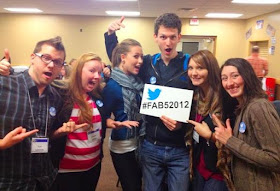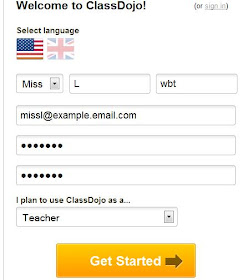Have you been seeing posts around blog-land about the classroom management website,
Class Dojo? While I didn't see an immediate need to check it out, the website's cute little characters drew me in and I knew I had to see what all the fuss was about. As I started exploring around some of the features I immediately began thinking of how this could be customized to create a super cute, interactive,
WBT Scoreboard!!
If you're naturally drawn to tech stuff this might be perfect for your classroom or, as Coach B often mentions, this could be the perfect thing to have in your back pocket to bring out when things need to be refreshed! The following is step-by-step tutorial of how you might set it up:
1 )
"Try it right now" / "Sign Up"
-Click on either one as it will
take you to the same form
_____________________________________________________________
2 )
Fill in You Information
- This is a pretty standard form
- Make sure you select that you are
a teacher.
_____________________________________________________________
3 ) Tour Time!
- Take some time to explore the different features of the site
- Any changes you make to any behaviours will be under the "Demo Class"
and will need to be redone when the tutorial is over and you make your own class
_____________________________________________________________
4 ) Create Your Own Class
- You can make as many classes as you want so it works perfect if see
multiple sets of students every day!
* Explore through the icon options to pick one that reflects your class
_____________________________________________________________
5 ) Begin Working on Your Class
- On your dashboard you should now see your "Demo Class" from the tour
and the class you've just created
- Click on "Start" to begin working on the set-up for your specific class
_____________________________________________________________
6 ) Add Students
- The very first thing you'll be asked to do is to add students to your class.
- Put in students name and add them to your class by hitting enter.
- You can modify their avatar by clicking the drop-down menu and dragging photos
onto the students picture
- Hit "Save & Close" at the bottom of the screen when done
_____________________________________________________________
7 ) Edit Your Class Specifics
- After adding students you will be taken back to your dashboard
- This time, click on "Edit class" which will allow you to edit the specifics of your
classroom like behaviours
_____________________________________________________________
8 ) Edit Behaviours
- Now that we have students we can now edit the behaviours.
- To really customize this for a WBT classroom I suggest deleting all
of the suggested behaviours so we can add our own.
- You can delete a behaviour by clicking on it and selecting "Delete"
under the "Save" button.
- Once the behaviours are clear you can click on the box to "Add your
own". Make sure to play around with the pictures too!
- Here are the ones I created:
- Once you have created the positive behaviours that you want you
can then click on the "Negative" button to edit the negative behaviours.
- Repeat the same steps as before to create appropriate negative behaviours
that fit in with your class.
- Here are the ones I created:
- Hit "Save & Close" at the bottom of the screen when done
_____________________________________________________________
9 ) Begin Using Your New "Scoreboard"
- When you start up your class you should now see all of your students
and you can begin using Class Dojo as your "Scoreboard"!
_____________________________________________________________
10 ) Award Points to Students
- To award a Scoreboard point to your students hit "Award Multiple Students"
at the top of the screen (see picture in Step 9)
- Select all of the students in your class (but NOT yourself) and then hit "Give
Award" at the top of the screen
- Select the award you want to give based on the positive behaviours you
set up previously
- The GREAT thing is that when students are awarded a point a screen
pops up on the screen briefly which is PERFECT for a 1-second party!
_____________________________________________________________
11 ) Award Points to the Teacher (Yourself) OPTION #1
- If you have made yourself part of the class (like I did as you can see in
the photos in Step 10), you can award yourself a point simply by clicking on
your character individually
- A BIG difference this time is that now you hit the negative behaviours that
are appropriate for why you are getting a point. In this example, I am awarding
myself a point on the Scoreboard because the students have "Continued to Talk
After Class-Yes"
- You can see now that the students have 1 point and the teacher has 1 point and
you can continue to use the scoreboard in this fashion throughout the class
_____________________________________________________________
12 ) Award Points to the Teacher (Yourself) OPTION #2
- If you do not want to make yourself part of the class there is another way to
award teacher points to yourself
- To award a negative Scoreboard point to your students hit "Award Multiple Students"
at the top of the screen (see picture in Step 9)
- Select all of the students in your class and then hit "Give
Award" at the top of the screen
- Under "Negative" select the award you want to give based on the negative behaviours
you set up previously
- Again, the GREAT thing is that when students are awarded a point a screen
pops up on the screen briefly which is PERFECT for a "Mighty-Groan!"
- You'll notice that the students now have no point bubbles next to their names
where they previously had green 1 point bubbles. Their negative point has
cancelled out the positive point that they previously earned.
_____________________________________________________________
13 ) Determining a Scoreboard Winner
- If you used Option #1 and made yourself part of the classroom then it will be
clearly displayed who won the Scoreboard game by who has more points next
to their names. If you see above, the students have won with 3 points as I only
have 2 points.
- If you used Option #2 you want to hit "End Class" at the top left of the screen
when your class is done and/or when that specific Scoreboard round is done.
- Once a class is done you will be able to see the results for the "Whole Class"
as well as for each individual student
- Make sure you set your range for "Today" so your results don't include information
from a previous day's class!
- If you see above, the students have won as they had (all together) 24 positive points
and only 16 negative points
_____________________________________________________________
If you play around with it, Class Dojo, has so many options that you can modify to make it fit your WBT classroom's needs! This tutorial shows the steps that I came up with while I was first looking at it but I'm sure once you are used to the options you could use it for even more WBT strategies! Perhaps you could use it to include Independents, if needed, or be used as part of the Super Improvers Wall for those students whose goals may fit in with the behaviours you have programmed in.
What other ways can you think of to use Class Dojo with WBT?
To learn more about Whole Brain Teaching, visit their
website.
To learn more about the WBT strategy of the Scoreboard, see my
previous post or visit this Whole Brain Teaching
article.
** I wrote this tutorial out of personal interest and was not approached by Class Dojo to promote their website.

-001.JPG)
-001.JPG)
-001.JPG)
-001.JPG)

.JPG)
.JPG)
.JPG)








.JPG)
.JPG)


.JPG)
.JPG)






.JPG)


.JPG)






.JPG)
























